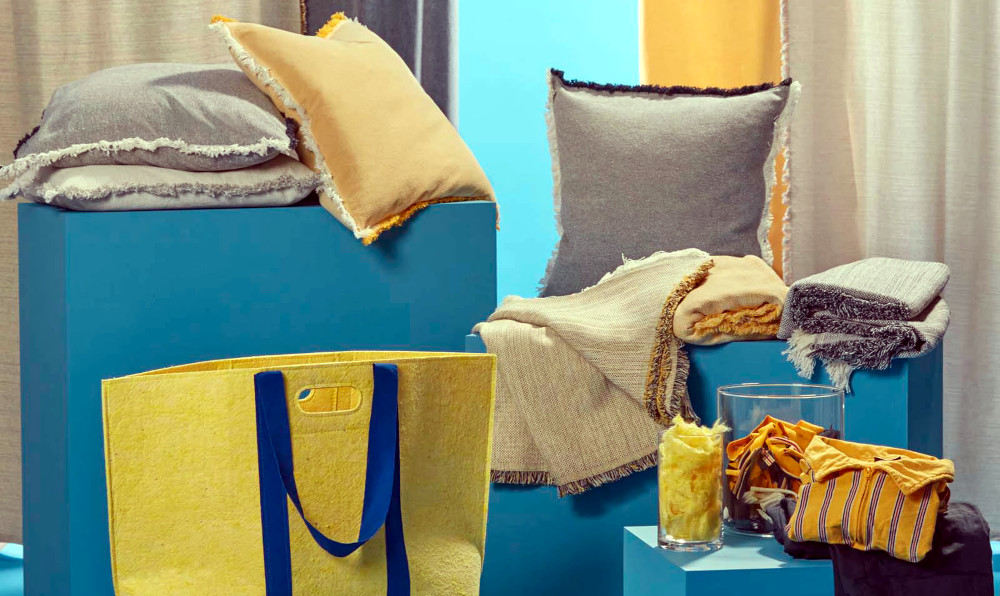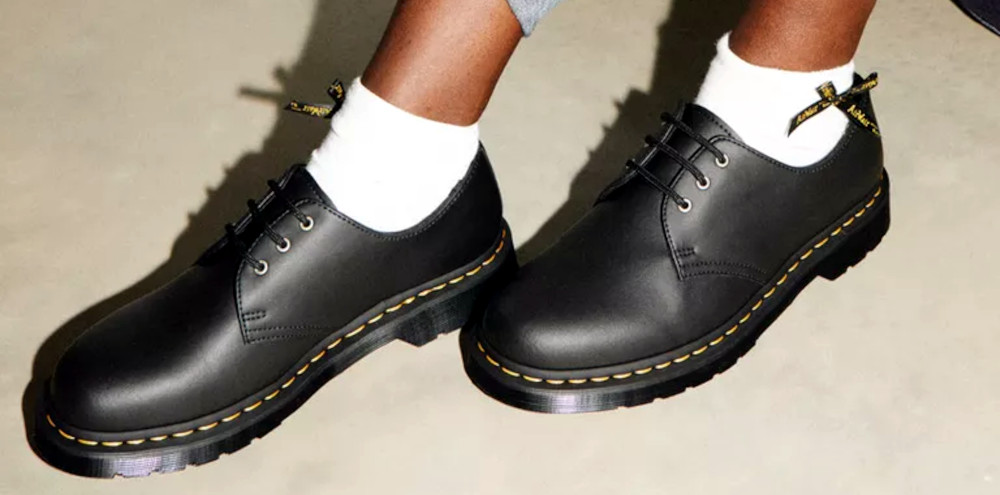IKEA’s VÄXELBRUK collection made from recycled employee uniforms
 Image credit: IKEA
Image credit: IKEA
While rolling out a new coworker uniform design over the past few years, IKEA
also collected hundreds of pallets of older uniforms — along with some overstock
of pre-ordered uniforms that were left unused due to the transition to the new
design. IKEA took the stockpile of fabric — and what it had learned from
extensive research with H&M about eliminating chemical contamination in
textile
recycling
— and embarked on a textile-recycling project, marking the company’s latest step
in its journey towards a fully circular business
model.
The result is
VÄXELBRUK
— a collection of throws, cushion covers, curtains and bags made using 300
tonnes of recycled uniforms collected in European markets from 2020 to 2022 —
which is finally set to launch soon in stores across Europe.
As Business and Innovation Deployment Leader Luca
Clerici explains in a
post,
the process of unmaking the garments inspired the particular range of items for
the collection — as the resulting fabrics soon revealed themselves to be
suitable for various uses, from curtains to office chair fabric.
And while some VÄXELBRUK products reflect IKEA’s trademark yellow and blue
colors, the goal was not to scream ‘IKEA’ colors.
“We got a lot of good ideas from the supplier in the development process and
ended up introducing other fabric colors from industrial textile surplus to
create a different fabric," Clerici says. "It helped make the yellow less yellow
and the blue less blue."
The making of colored fabrics, especially multi-colored ones, usually requires
dyeing
— a process that can add quite a cost to both resources and the price of the
final product in stores. A key takeaway from the making of VÄXELBRUK was being
able to adjust colors without having to go through a dyeing process by combining
the colors of the recycled fibers to create the desired color effect.
But Clerici says one of the most challenging — and valuable — lessons learned
from the making of VÄXELBRUK didn’t have to do with product development or
design.
“It was the first time we managed and repurposed our own potential waste within
IKEA at this scale; so we had to learn to navigate quite a complex landscape in
terms of requirements, legislation and logistics. How to move the material,
working with the right carriers with special licenses to receive and manage
them. We studied all of these things very closely."
These kinds of complexities are the reason many of these explorative projects
have a limited extent and release, and why this first-time project took place in
European markets alone. And it’s the kind of groundwork that makes way for
relatively swift add-ons thereafter, as proven by the VÄXELBRUK bag — the only
product in the collection to not be made fully from recycled post- and
pre-consumer recycled materials.
When one of the new uniform top fabrics turned out to be a little too
transparent, the team was able to repurpose the stretchy t-shirt material as
well — adding low-melt fibers made with virgin polyester, which acts a sort of
glue between the fibers — to create the woven feel of the VÄXELBRUK bags.
Clerici recounts the excitement of the marathon sprint and team effort behind
the collection — and how it set an example for recycling and repurposing
materials within IKEA.
“There were so many cross-disciplinary learnings, not only about textiles. We’re
sharing these across IKEA for people to use in everything from the supply chain
to product development and design. Many good things have happened because of
this project."
Dr. Martens’ Genix Nappa collection made from reclaimed leather
 Dr. Martens' 1461 3-Eye Shoe in reclaimed leather | Image credit: Dr. Martens
Dr. Martens' 1461 3-Eye Shoe in reclaimed leather | Image credit: Dr. Martens
Meanwhile, Dr. Martens has launched its Genix
Nappa collection — made from
reclaimed leather from Gen Phoenix, the first company
to sustainably recycle leather at scale. The company aims to tackle waste by
rescuing leather offcuts that would otherwise be destined for landfill and uses
them to create a soft yet durable new material.
To create the Genix Nappa material, Dr. Martens worked with Gen Phoenix to
leverage the company's groundbreaking technology — which breaks waste leather
down to the fiber level and then uses the power of recycled water to rebuild it
into a premium and durable recycled material.
"We are excited to join forces with Dr. Martens on the first sustainable remake
of its most iconic boot styles,” says Gen Phoenix CEO John
Kennedy. “This partnership
is proof that heritage brands can implement circular models that benefit the
planet without changing the integrity of the product, bringing high-quality
shoes responsibly to market for everyone to enjoy."
Durability is a hallmark of all Dr. Martens' products, which have been Made
Strong since 1960; and Gen Phoenix's 15-year legacy of producing durable,
high-performing recycled material innovations for the aviation, rail and bus
industries has positioned the company to now have an impact in fashion and
footwear.
Reclaimed leather. Remade to last.
Genix Nappa offers the quality, durability, comfort and strength of conventional
leather with a lower carbon impact. The leather offcuts are taken from tanneries
and put through Gen Phoenix's proprietary process to separate the leather fibers
before re-entangling them, producing a roll of re-engineered, reclaimed leather
which is then used to manufacture the footwear. The Genix Nappa material
contains over 50 percent waste leather.
Top to bottom, the Gen Phoenix's process is environmentally responsible — it's
powered by 100 percent renewable electricity and the brand recycles 95 percent
of water in production — and enables circular material production with the scale
necessary to make a true impact. For both brands, sustainability through
longevity is a key focus and Gen Phoenix is thrilled to support Dr. Martens as
it takes the next step in its journey to create durable, lower-impact footwear
that will help support a more sustainable future.
The new collection will feature remakes of Dr. Martens' signature 1460 Lace-Up
Boot, 1461 3-Eye Shoe and 2976 Chelsea Boot.
"The sustainability challenges of today are complex, and circular business
models are one of them,” says Dr. Martens Global Head of Sustainability Tuze
Mekik Arguedas Schwank. “At DM's, we
have been taking steps forward in our journey towards circularity; and Genix
Nappa is a great example of one of them. It demonstrates that waste is a
valuable resource and shows how we can think differently about our products into
the future. We can't wait to hear what our wearers think!"
Dr. Martens' partnership with Gen Phoenix demonstrates the two UK-brands' shared
commitment to sustainability, and follows the iconic shoe brand’s strategic
investment
in the British startup in 2023. Through a revolutionary circular process that
earned the brand recognition as one of Fast Company's 2024 Most Innovative
Companies,
Gen Phoenix rescues leather offcuts destined for landfill and regenerates them
into a premium recycled leather material; the company has diverted thousands of
tons of material from landfill since 2007.
This also marks Gen Phoenix's second partnership with a heritage fashion brand
to develop more sustainable offerings while still maintaining the same quality
and luxury customers have grown to love: Last April, Gen Phoenix integrated its
material innovation into Coach circular sub-brand
Coachtopia's
circular line of handbags and leather goods.
Get the latest insights, trends, and innovations to help position yourself at the forefront of sustainable business leadership—delivered straight to your inbox.
Sustainable Brands Staff
Published Apr 2, 2024 2pm EDT / 11am PDT / 7pm BST / 8pm CEST